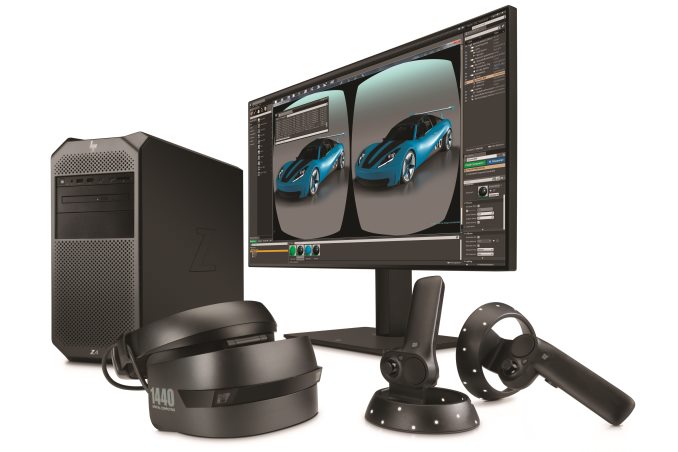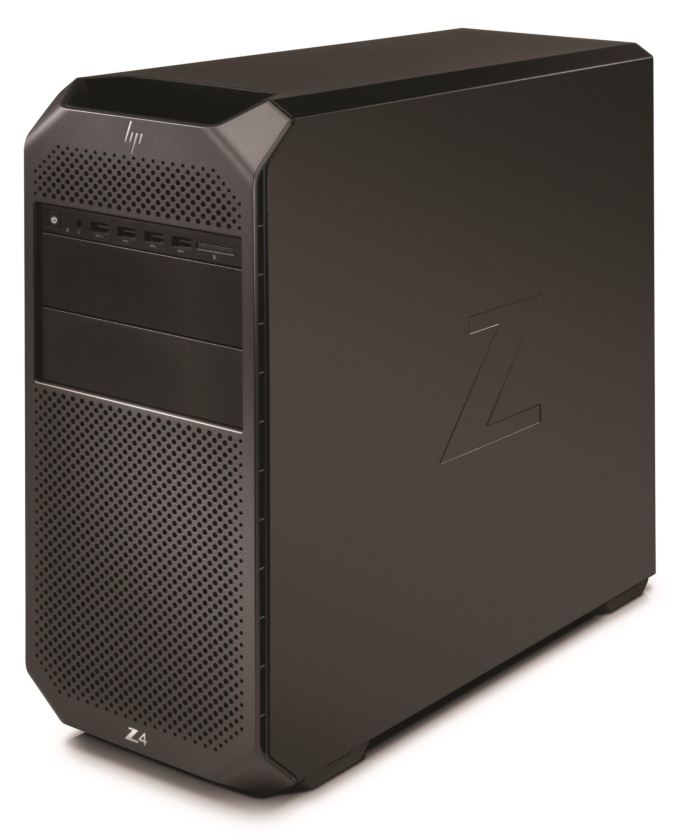HP Z4 Workstations Get Xeon W and Core X, 18-Core
by Joe Shields on February 5, 2018 9:02 AM EST- Posted in
- Systems
- HP
- Workstation
- Enterprise
- Professional
- Skylake-SP
- Skylake-X
- Xeon-W

Today, HP has released information on the update to its Z4 workstation line. The Z4 workstation is now available with both Xeon W and Core-X based processors for the new generation, both based on Intel's latest high-performance Skylake-SP core. Options for Xeon W, which will enable RDIMMs to be used, include the range of eight on-roadmap processors, from the quad core W-2123 ($294) up to the flagship W-2195 offering eighteen cores ($2550) in a 140W envelope. The Z4 lineup is also able to support the Intel Core X (Skylake-X) processors from the consumer high-end desktop line.
Access to the Skylake-X processors will give customers the ability to step into the workstation platform at a slightly lower price point than with the Xeon W based systems. The W series offers a bit more security and lifecycle management with vPro enablement, while the X-series is more affordable and offers higher clock speeds in many SKUs. There are a few other differences in system configurations, such as ECC RDIMM memory and network/storage differences which will also contribute to a difference in cost.
The Core X-based Z4 systems will have a single gigabit ethernet port and a single M.2 slot, while the W-series machines offer dual gigabit ethernet ports (supporting teaming NIC) and dual M.2 slots. Both systems use professional video cards, are able to use up to dual NVIDIA Quadro P6000 GPUs or AMD Radeon Pro WX 9100 GPUs.
HP anticipates their indutrial clients, particularly in the Healthcare, Civil Engineering, and AEC, will use the Xeon W systems for the processor and memory reliability, expandability, manageability, and security reasons. The Core X variants are expected to be aimed at clients from the PC space, such as those in game development, rendering, and VR development.
| HP Z4 G4 Workstation | |||||
| Xeon-W | Core-X | ||||
| CPU Support | Xeon W series | Core X series | |||
| Core Count | From Xeon W-2123 (4C/8T) to Xeon W-2195 (18C/36T) |
From Core i7-7800X (6C/12T) to Core i9-7980XE (18C/36T) |
|||
| Memory | Up to 256GB ECC RDIMM | Up to 128GB Non-ECC UDIMM | |||
| NVIDIA Graphics | Up to Dual NVIDIA Quadro P6000 (3840 CUDA Cores, 24GB GDDR5X) | ||||
| AMD Graphics | Up to Dual AMD Radeon WX9100 (4096 SPs, 16GB HBM2) | ||||
| Intel vPro | Yes | No | |||
| Network | Dual 1 GbE ports w/teaming | Single 1 GbE | |||
| M.2 Slots | Dual M.2 | Single M.2 | |||
The Z4 Workstation is available now. Pricing will start at $1499.
Related Reading:
- Lenovo Details Its Standalone DayDream VR HMD, The Mirage Solo at CES 2018
- Vive Pro VR Headset with Higher-Res displays, Two Cams, Headphones
- HTC Announces Standalone Vive Focus with 6DoF Tracking, Cancels Daydream VR Headsets
Source: HP











20 Comments
View All Comments
AdditionalPylons - Monday, February 5, 2018 - link
I wish these companies would start integrating Nbase-T networking so that there would be some incentives for others to make more affordable switches and start the wired multi-gigabit revolution. It's almost ironic that 1GbE speeds will soon be beaten by cellular data!smilingcrow - Monday, February 5, 2018 - link
Not beaten in real world usage though.FreckledTrout - Monday, February 5, 2018 - link
True but we are talking wired LAN not even internet speeds. I do find it a bit silly 1GbE is still the fastest option for any reasonable price that 99.9% home users would consider. Usually you would see some trickle down and I think we are starting to but boy has it been *slow*.Elstar - Thursday, February 8, 2018 - link
[Old man mode] Some things never change. I remember the same complaints during the transition to Fast Ethernet, and then again to Gigabit Ethernet. The problem is that most customers care more about price than being ahead of the curve. Also, computer vendors are reluctant to upgrade to "Better" Ethernet until consumer version of "Better" Ethernet switches becomes reasonably priced too.peevee - Thursday, February 8, 2018 - link
Yes, it is hard to understand why 1GbE is stuck there for 19 years now, when 10G is available for 12. Hell, 100GbE is standard from 2010, you'd think the industry would choose and implement a particular optical standard (100BASE-DR for example) by now in every cheap PC.Elstar - Thursday, February 8, 2018 - link
This doesn't contradict what I wrote. The problem is demand and cost, not proof of concept. The demand for "better" Ethernet just isn't there and the cost of "better" Ethernet still need to come down before vendors see it as worthwhile.peevee - Thursday, February 8, 2018 - link
Transitions to 100 and 1Gb were much faster.Samus - Monday, February 5, 2018 - link
I agree there needs to be a push somewhere. It's just such a slow adoption not just because of switches but the utter lack of CAT6 in most buildings that haven't been renovated. CAT5e does not guarantee Nbase-T, let alone 2.5/5Gbps connections, because there are distance limitations that are easily broken in a decent sized office with a network closet.Another thing people don't talk about is patch panel compatibility with beyond-1Gbps connections. Most patch panels screw up the handshake if they aren't CAT6-compliant, and although it's a relatively cheap fix, it's just another infrastructure problem holding N-base back.
HStewart - Monday, February 5, 2018 - link
What would be interesting is a review of same level processor with same graphics, memory storage but one being Xeon-W and other being X-core.Of course on additional test one should take account of dual M.2's, dual 1gbs network and extra memory. Especially if M.2's could be configured in Raid. Xeons have been known to have better IO performance.
Cooe - Monday, February 5, 2018 - link
18-core/36-thread Skylake-SP HCC + dual full fat 16GB pro Vega's = one absolute mother of a compute/render box. I fully imagine the MSRP of such a beast to be just as insane.